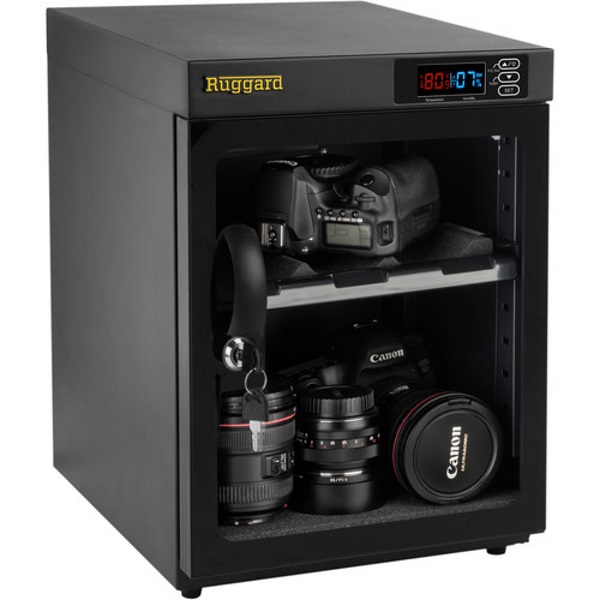
Living in New York City has been a real education on humidity, and its effect on various things in my apartment. The moisture caused by the humidity has not only ruined several electronic components of mine, but also many fabric items. As I learned more about my cameras and lenses, I began to understand the effect that the moisture from humidity can have on such sensitive electronic equipment. In addition, I read an article on the cost of fixing lenses and cameras when the moisture takes its toll on their mechanisms. I decided to invest in a Dry cabinet to protect my camera equipment and obviously my investment in them.
After much research, and because of my space limitations, I chose the Ruggard Electronic Dry Cabinet in the 30L size. I felt that while it is somewhat small, it would at least help me to protect the equipment that was not in my Pelican air-sealed cases. This dry cabinet is an electronically controlled humidifier and also protects the equipment from dust and other bad elements. It offers very nice features including a locking see-through door that seals when closed, interior lighting, adjustable shelves, and a multi-voltage power supply. Much to my surprise and satisfaction, the seemingly small cabinet is quite roomy inside. I have been able to store a large professional Canon DSLR with the extended battery holder attached, and 12 lenses ranging in size from the large Sigma 70-200mm lens all the way through the range to the small Canon 40mm pancake lens. None of the lens are stacked, and each occupies its own footprint. I also love the digital display that continuously shows the temperature and humidity, and I can set the desired humidity level from the control buttons next to the display.
I would recommend this dry cabinet to anyone looking to protect their sensitive equipment from the perils caused by humidity and other bad environmental elements, and since it is available in 7 sizes, the 30L being the smallest, there is a size to accommodate most camera equipment needs.
If you are interested in the Ruggard Electronic Dry Cabinet, you can head over to B&H Photo Video or Amazon to purchase one at the starting price of $149.



Gadgeteer Comment Policy - Please read before commenting
These cabinets are very nice, but unless you have $ to throw away, not necessary for most. Humidity itself is not a significant threat to electronics, although very high (tropical) humidity can cause poorly designed contacts to oxidize eventually. With modern inorganic lens coatings, fungus is also not common. Unless you routinely have condensing moisture (winter shoot, coming back into a warm, moist room) they are overkill. You can get small packs of silica gel that allows you to recharge in an oven. The most expensive are in a metal case, but many of the cheap flexible plastic packs can also be re-charged. You put one of them plastic container with your gear. You check them once a month, throwing in a new one in when the color changes. In most locations, they will last far more than a month and you can extend your “check” period accordingly. When you have a few that need recharged, you bake them in a 200F oven for a couple hours. Problem solved with a $5 storage bin and a $1 silica pack. And it will do everything these cabinets do. And if a thief comes by, they won’t say “hey, look at that display case with $3000 of cameras in it”
Hi Patl,
I have used the Silica gel packs, including the ones in the metal case. I have a serious humidity problem in my home and I ultimately decided to go with the dry cabinet. I have several household items that have been damaged by the moisture from the humidity. I also have a friend who has the same problem and it did affect his lens. Not sure how he had the lens stored, but he had to send it to Canon for repair. The dry cabinet is relatively cheap and it works. It also looks nice as a display. I guess it comes down to a matter of personal choice.
I keep all my camera equipment in a metal cabinet with a ” damp chaser” on the bottom. It is a rod with a heating element plugged into the wall. They are also used in pianos. My equipment is on metal wire shelves which allow for good good air movement.
Hi Norm,
You have a good method to protect against humidity. I like the dry cabinet both for function and display.
Wow, I never realized New York was so humid. We get pretty humid in San Antonio and also in Houston where I have lived. Being in the south, we pretty much run our AC year around and that really controls the humidity inside the house. They now have variable stage compressors that work with heating and cooling where the fan will stay running virtually all the time keeping the house feeling cooler and the humidity at a nice constant level.
Do you not run an AC in your house that often or even heat?
Hi Lynn,
I live in a gated community with buildings that are condos or apartments. The maintenance crew controls the central heat, and I am not sure how they determine what is the correct setting. I suspect that they use a sensor that is at the highest point of the structure so every level below is messed up. The amount of moisture that builds up inside especially on the outer walls and windows is ridiculous. Everyone complains about the same issue. And, I am right next to the ocean, so that may be a factor as well.